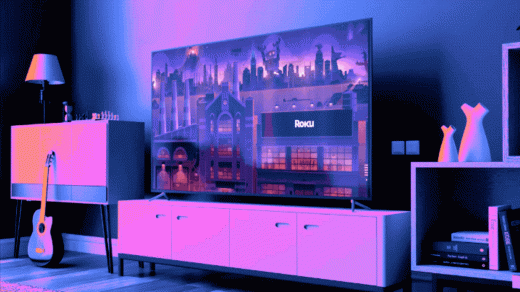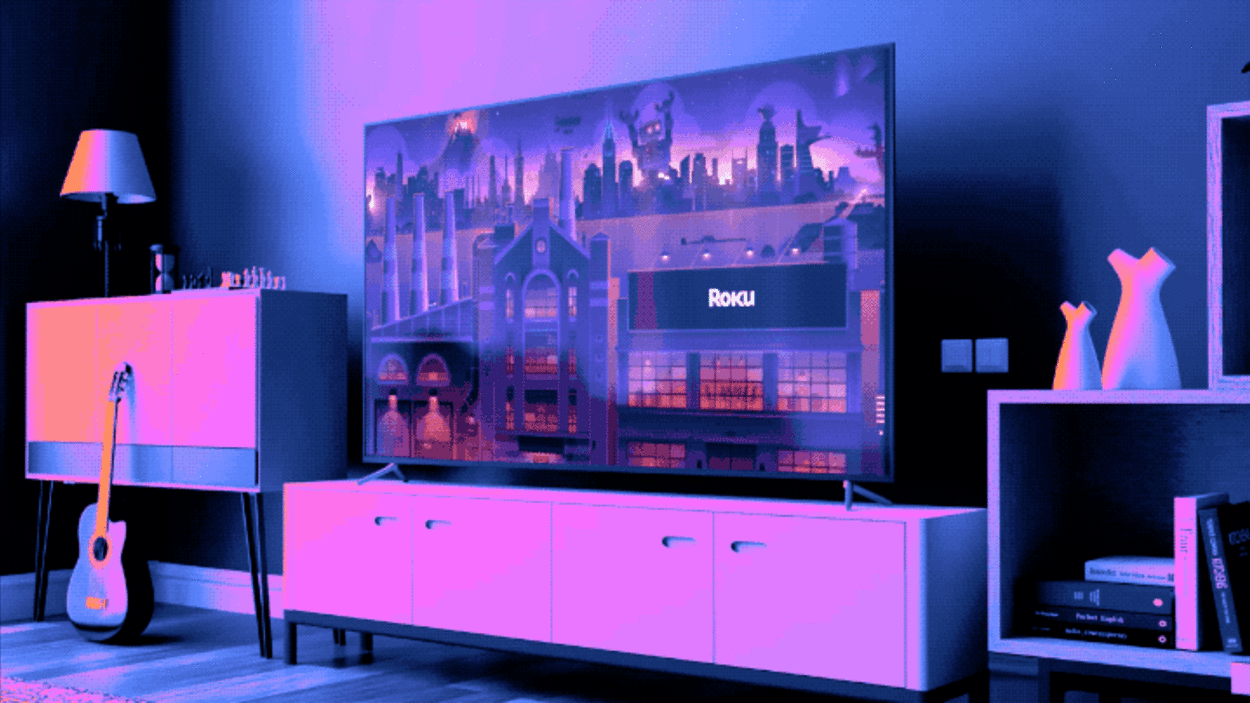Why is Roku bouncing back while other streamers struggle? Take a look at Roku City
Branded is a weekly column devoted to the intersection of marketing, business, design, and culture.
Presumably when you flick on Roku, the streaming hub that claims more than 70 million active accounts, it’s because you want to watch a show or a movie or an event. But it’s become increasingly clear that lots of people spend at least a little time watching . . . Roku’s screensaver. The dark cityscape with Roku-purple and magenta highlights that scrolls by on an endless, relaxing loop was given the name Roku City on social media and in various memes. “This particular screensaver has taken on a life of its own,” the New York Times declared last year, calling idle Rokus “the unlikely venue for a massive public art experiment.”
Now Roku itself has been taking a closer look at its digital metropolis, and has gradually begun adding something new: advertising.
It’s a fledgling initiative. But while other streamers are cutting costs and trying to minimize subscriber churn, it’s also a signal that Roku is finding adventurous ways in which to grow. (August 11, 2023), the company announced strong quarterly revenue growth ($847 million, up 11% over last year) and beat expectations on second-quarter earnings, sending its stock price up more than 25% in midday trading Friday. Its official shareholder letter specifically called out the fact that its “iconic screensaver” is now “opened for major brand advertisers,” and Roku City ads got a shout-out during its earnings call as having strong potential.
A few weeks back, Grimace popped up in Roku City, bringing McDonald’s purple-shake-and-Happy Meal campaign—and the Golden Arches—onto its imaginary Main Street for a time, in what Roku said was the first branded-ad deal on the screensaver. More recently, the Barbie movie’s overwhelming marketing campaign included Roku, and part of its presence on the service included temporarily adding “Barbie’s extravagant three-story Dreamhouse,” to Roku City, “equipped with a dance floor, hot pink slide, and extensive shoe closet,” according to a company blog post. There was also a Barbie-branded Roku Movie Theater, and billboards pointing to the film’s trailer. Most recently, a Walmart and an Acura dealership have popped up. (Roku Suburb?) The company has said there is more to come (and in its earnings call suggested that demand is higher than capacity).
The cityscape, which debuted back in 2018, was created by Kyle Jones, then a freelance graphic designer. Jones jammed the digital urban environment with dozens of movie references, from King Kong to Sleepless in Seattle, with an aesthetic that balanced the art deco and the noir. The foreground is a vibrant strip of theaters, cafes, and apartment buildings; in the background, across a river, the scene is surprisingly threat-filled, with a volcano, a menagerie of rampaging monsters, and other chaos. The weird contrast is part of what makes Roku City worth staring at—or at least spacing out to while you wait for your partner to finish making tea and pick an actual show. “What would it be like,” Gawker writer Olivia Craighead wondered, “to live in such a place, where there is peace in one borough while just a river away there is mass hysteria and a giant robot is terrorizing the masses.”
Actually, low-key advertising was part of the fabric of Roku City (initially referred to by the company as “City Scroll: Movie Magic”) from the beginning, with virtual billboards for the Roku app and the latest shows on Roku’s own channel. But as Roku has continued to tinker with and expand its business model—adding more original programming to its channel, most notably the Weird Al movie; cutting a deal with Shopify to enable viewers to buy certain products via their TV remotes—it has evidently concluded that Roku City is valuable real estate. After all, 85% of Roku users “have sat and watched Roku City scroll by,” according to the company, “and two-thirds say they would love to visit if given the opportunity.”
In the run-up to this year’s Newfronts/upfronts marketing scrum (where platforms woo potential advertisers), Roku promoted its imaginary city on actual Times Square billboard screens. In May, streamer Paramount+ got its own temporary Roku City “neighborhood” in a kind of brand takeover that reimagined the digital streetscape with Paramount-centric iconography, from its logo to visual nods to Top Gun: Maverick and Star Trek, among others; billboards led straight to Paramount content. The McDonald’s and Barbie campaigns, more integrated into the standard Roku Cityscape, followed. That variety underscores Roku’s unusual position, as both a gateway to content and a venue for advertising.
Roku currently loses money, but has beaten expectations in recent quarters. Going into its earnings announcement (August 11, 2023), its share price had surged more than 75% this year—and rose sharply in after-hours trading following its earnings report after (August 11, 2023)’s close and continued to soar on Friday. It is still well off its 2021 highs, reflecting broader pressure on the streaming category in general to prove profitable business models. But its latest revenue numbers suggest it remains a popular streaming hub for tens of millions of users—active accounts rose by nearly 2 million over last quarter, reaching 73.5 million. And tapping into the curious popularity is consistent with its efforts to position itself as somewhat above the so-called streaming wars.
At the moment, it’s unclear how much money Roku City ads might bring in: the company declined to comment, citing the quiet period before its earnings announcement; and in fairness, the effort is only a few weeks old. But the digital metropolis clearly has a role in Roku’s ideal advertising future. It makes brand campaigns “unmissable,” as one Roku exec put it at this year’s Newfront pitch to marketers. “Many are renting you ad space,” another exec added, “but Roku is building an entire ad-friendly world.” Its screensaver city aims to be on that map.
(22)



